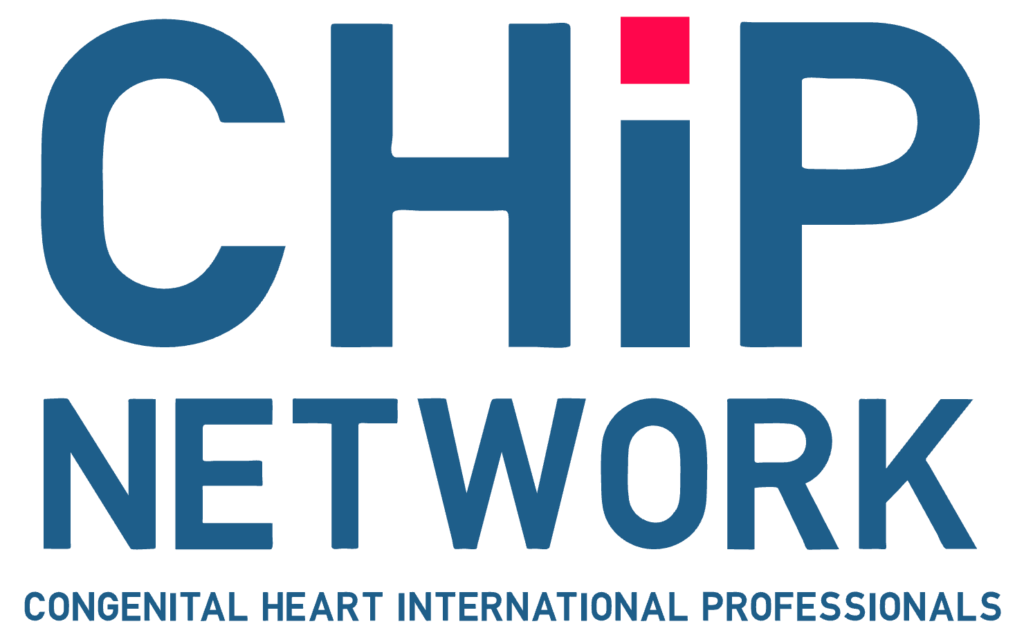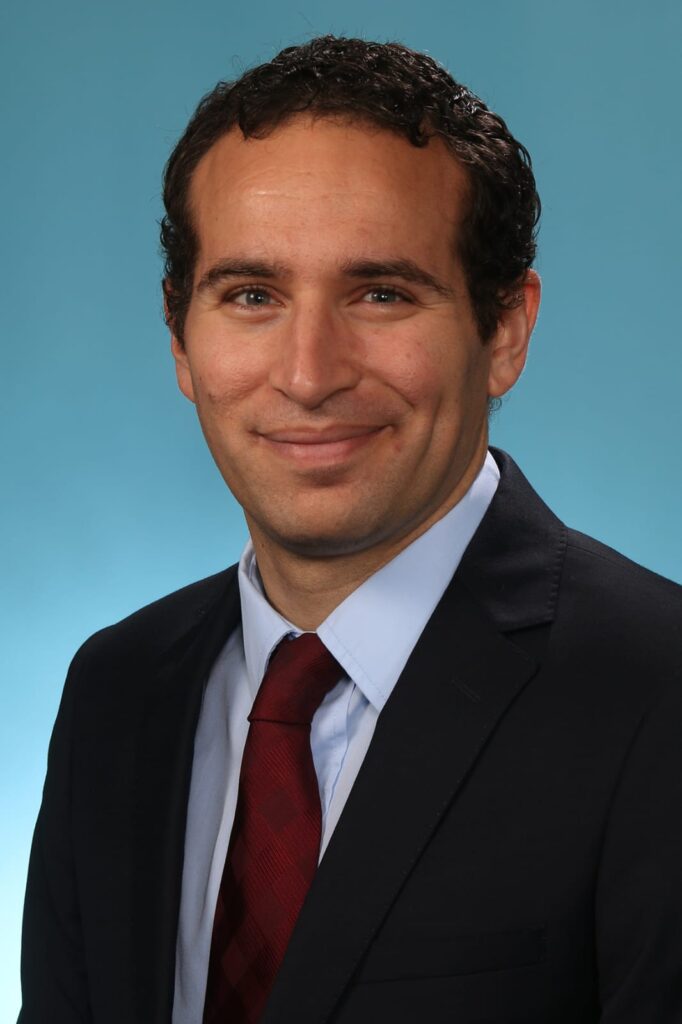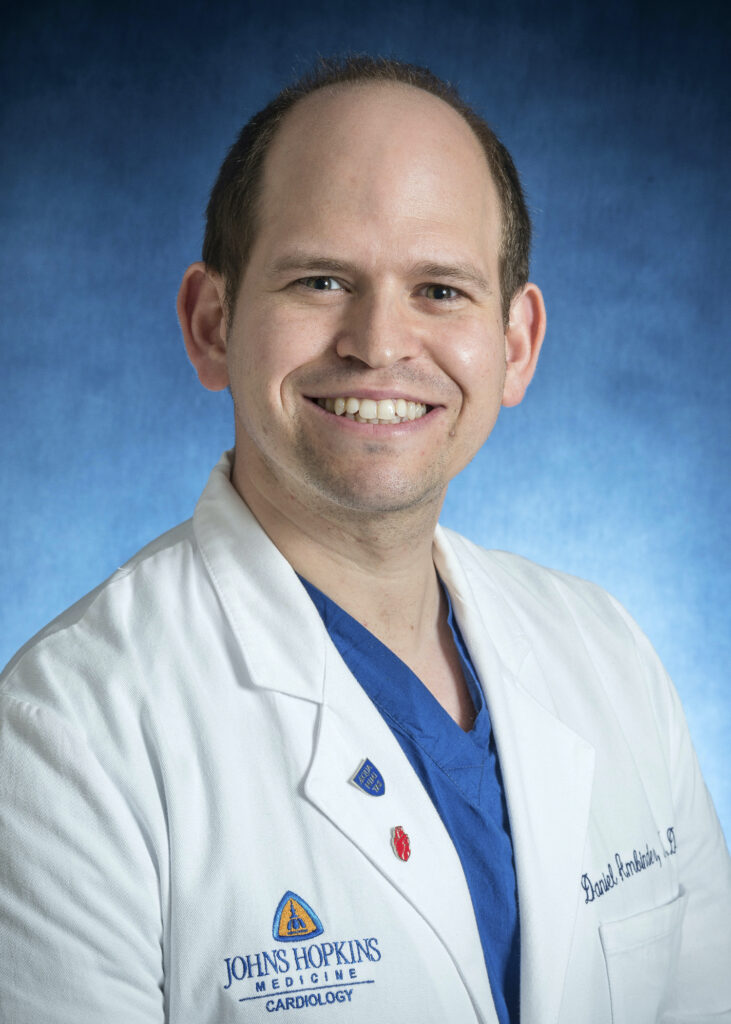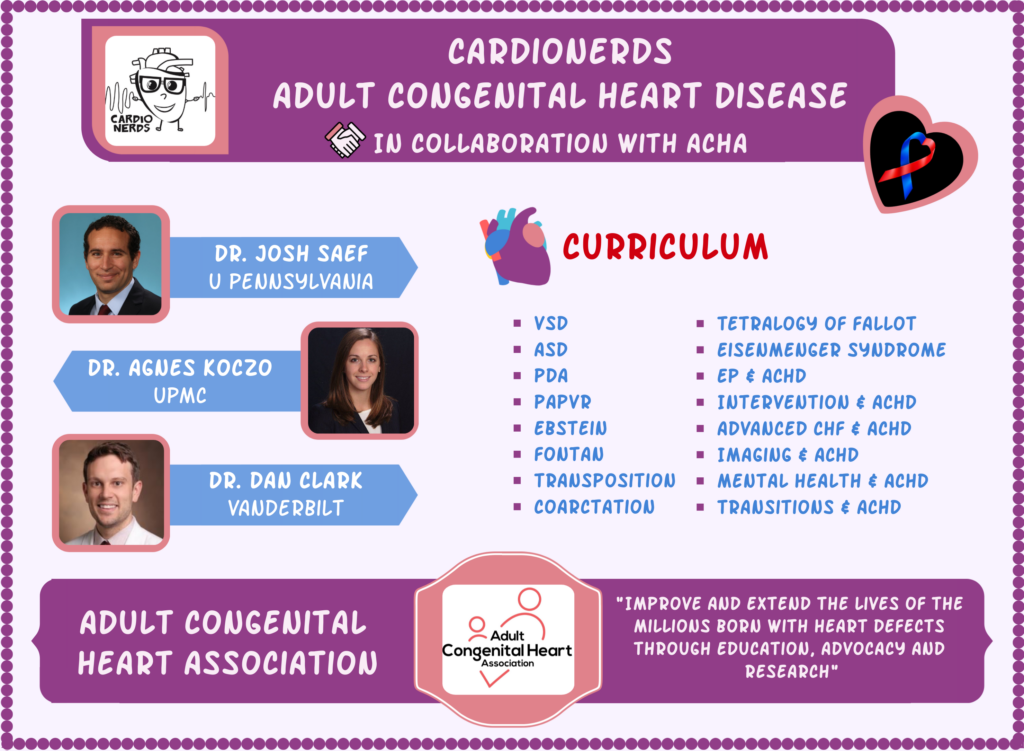
 Cardionerds: A Cardiology Podcast
Cardionerds: A Cardiology Podcast 170. ACHD: Transposition of the Great Arteries with Dr. Maan Jokhadar
Mentorship Drives ACHD Passion
- Dr. Maan Jokhadar was drawn to congenital heart disease by its complexity and inspiring mentors.
- He values the unique, long-term patient relationships built in adult congenital heart disease care.
D-TGA Anatomy Demystified
- D-transposition of the great arteries (D-TGA) involves arterial-ventricular discordance where the aorta arises from the right ventricle.
- The "D" refers to ventricular looping, separate from the spatial relationship of great arteries.
Parallel Circuits in D-TGA
- In D-TGA, deoxygenated blood circulates systemically and oxygenated blood recirculates to the lungs.
- Survival depends on mixing between the two circuits through atrial, ventricular, or arterial level defects.
In this episode, CardioNerds (Amit Goyal), ACHD series co-chair, Dr. Josh Saef (ACHD fellow at University of Pennsylvania) and episode lead fellow, Dr. Brynn Connor (Pediatric Cardiology fellow at Lucile Packard Children’s Hospital at Stanford) are joined by Dr. Maan Jokhadar (Advanced heart failure and adult congenital heart disease specialist at Emory University) to discuss transposition of the great arteries. Audio editing by CardioNerds Academy Intern, Dr. Maryam Barkhordarian.
The CardioNerds Adult Congenital Heart Disease (ACHD) series provides a comprehensive curriculum to dive deep into the labyrinthine world of congenital heart disease with the aim of empowering every CardioNerd to help improve the lives of people living with congenital heart disease. This series is multi-institutional collaborative project made possible by contributions of stellar fellow leads and expert faculty from several programs, led by series co-chairs, Dr. Josh Saef, Dr. Agnes Koczo, and Dr. Dan Clark.
The CardioNerds Adult Congenital Heart Disease Series is developed in collaboration with the Adult Congenital Heart Association, The CHiP Network, and Heart University. See more
Claim free CME for enjoying this episode! Disclosures: None
Pearls • Notes • References • Guest Profiles • Production Team
Pearls
(1) In D-TGA following an atrial switch operation, the right ventricle IS the systemic ventricle!
(2) Evaluation of systemic right ventricular function often requires use of both transthoracic echocardiography and cardiac MRI.
(3) Use of medical heart failure therapies should be individualized, without any proven long-term mortality benefit and potential unique complications in this patient population (i.e. SA node dysfunction).
Show notes
D-transposition of the great arteries (D-TGA) is one of the most common forms of cyanotic congenital heart disease presenting in the newborn period. Anatomically, d-transposition of the great arteries is characterized by atrioventricular concordance and ventriculoarterial discordance, such that the aorta arises from the morphologic right ventricle and pulmonary artery arises from the morphologic left ventricle. The resultant physiology is that of a parallel circulation, with deoxygenated blood recirculating in the systemic circulation (via the RA-RV) and oxygenated blood recirculating in the pulmonary circulation (via the LA-LV). At birth, this invariably results in cyanosis, with survival dependent upon adequate mixing of the two circulations via an atrial or ventricular level defect.
Prior to surgical advances in the late 1950s, this lesion was uniformly fatal, with most infants dying before their first birthday. The subsequent development of the Senning and Mustard atrial-level repairs led to good immediate outcomes and improved long-term survival. However, following these “physiologic” types of repair, patients are far from cured, with several long-term established complications, including (1) dysfunction of the systemic right ventricle, (2) tricuspid regurgitation (the systemic atrioventricular valve), (3) atrial and ventricular arrhythmias, and (4) systemic and pulmonary venous baffles leaks and obstruction. These complications ultimately lead to substantial morbidity and premature mortality, with ACHD providers facing unique challenges in the medical and surgical management of this heterogenous patient population.
1. What are the basic anatomic features of d-transposition of the great arteries (d-TGA)?

- D-transposition of the great arteries is defined by the origin of the arterial trunks from the morphologically inappropriate ventricle, specifically with the aorta arising from the morphologic right ventricle (now the systemic ventricle) and the pulmonary trunk arising from the morphologic left ventricle.
- This is termed “ventriculoarterial discordance”, and importantly, does not define the spatial relationship of the great arteries. Rather, the “d” terminology refers to the looping of the ventricles and distinguishes d-TGA from l-TGA (or congenitally corrected transposition), where there is additional atrioventricular discordance.
- The resultant physiology is that of a parallel circulation, with deoxygenated blood recirculating in the systemic circulation and oxygenated blood recirculating in the pulmonary circulation. At birth, this invariably results in cyanosis, with survival dependent upon adequate mixing of the two circulations via an atrial or ventricular level defect.
- There are three major anatomic variations in dTGA, including dTGA with an intact ventricular septum (most common), dTGA with a ventricular septal defect, and dTGA with LVOT obstruction. These anatomic subtypes can lead to variable presentations in the neonatal period, as well as pose unique challenges to surgical repair, and are therefore important diagnostic considerations.
- The arrangement of the coronary arteries and their spatial course can additionally be highly variable, posing added complications when performing the arterial switch operation (which requires reimplantation of the coronary arteries into the neo-aortic root). The most common, “usual,” arrangement is the left coronary artery originating off the anterior facing sinus, and the right coronary artery originating off the posterior facing sinus.
2. What surgical approaches have been utilized in the management of D-TGA?What are the key features of aortic coarctation anatomy?
- Prior to surgical advances in the late 1950s, this lesion was uniformly fatal, with most infants dying before the age of 1 year.
- Infants were initially palliated with an atrial septostomy, which allowed for mixing at the atrial level and improved survival in the immediate newborn period. However, these infants were still left with profound cyanosis, with inevitable mortality in the first year of life.
- In the mid-1950s, the Senning (1958) and Mustard (1964) atrial-level repairs were first performed, with good short-term outcomes and improved long-term survival.
- In the Senning procedure, a baffle is created within the atria that redirects the deoxygenated caval blood to the mitral valve and the oxygenated pulmonary venous blood to the tricuspid valve with use of native atrial tissue.
- Mustard subsequently described a simpler technique with creation of an atrial baffle using synthetic patch material.

- By the late 1980s, late complications of these repairs became well recognized, with the ultimate adoption of the neonatal arterial switch operation, which remains the gold standard for surgical management of transposition.

3. What are the long-term complications of the Mustard and Senning procedures?
- Systemic Right Ventricular Dysfunction:
- Clinical Features – Systemic RV dysfunction is an evitable consequence of the atrial switch operation, with 50% of patients developing right ventricular systolic dysfunction by 30 years of age.
- While right ventricular dysfunction is often mild and clinically asymptomatic for several years, patients ultimately develop related symptomatology over the subsequent 10-20 years.
- Most commonly, patients present to care with diminished exercise tolerance, with symptomatic arrhythmias being an additional common reason for patients to seek care.
- Diagnosis
- Accurate assessment of RV size and function in this population is critical for adequate surveillance and management planning. However, quantitative right ventricular assessment remains challenging, with no model for comparison and no clear criteria for abnormalities.
- Volumetric assessments are the gold standard, although made difficult by the complex geometry of the right ventricle.
- Cardiac MRI is most commonly utilized to assess RV size and systolic function, and additionally permits simultaneous evaluation of the systemic and pulmonary venous baffles and quantitative assessment of the degree of tricuspid regurgitation (the systemic AV valve).
- Transthoracic echocardiography is still routinely employed for serial evaluation of systemic right ventricular function. However, providers should have a low threshold to obtain further advanced imaging with any significant change in symptomatology or qualitative decrement in right ventricular systolic function on serial echocardiographic assessment.
- Management
- Medical Therapy: In contrast to ischemic cardiomyopathy, there are no long-term, randomized, placebo-controlled drug trials evaluating the efficacy of ACEI/ARB/ARNI or beta-blockers on systemic RV function. Small studies performed to date have not shown any appreciable benefit of ACEI/ARB on improving right ventricular ejection fraction or exercise capacity, which may reflect minimal baseline activation of the renin-angiotensin-aldosterone system in this form of heart failure. Use of beta-blocker therapy pathophysiologically makes sense, specifically reducing myocardial oxygen demand and allowing for improved ventricular filling; however, prior studies have produced mixed results, with evidence of improved right ventricular remodelingalthough no appreciable improvement in right ventricular ejection fraction, functional class, or long-term survival. Use of beta-blockers should also be cautioned in patients with established SA node dysfunction.
- Left Ventricular Re-Training: Conversion to an arterial switch operation often requires a staged approach to ensure that the left ventricle is adequately “trained” to handle systemic pressures. The left ventricle becomes rapidly deconditioned with time when continually exposed to the low-resistant pulmonary circuit, losing its ability to generate systemic pressure. Therefore, initial pulmonary artery banding is often required for left ventricle re-training, although this strategy has had variable success rates. Historically, age has been deemed an important factor in predicting the success of pulmonary artery banding, although this has not been consistently shown. The criteria for successful conversion post-banding are often extrapolated from l-TGA literature, and include generation of near systemic or systemic left ventricular pressures, presence of normal left ventricular systolic function, absent left ventricular diastolic dysfunction (LVEDP <12), an adequate LV mass (65 g/m2), and absent significant AV valve regurgitation.
- Cardiac transplantation has been successfully performed in this patient population, and should remain a consideration in medically refractory heart failure.
- Arrhythmias & Sudden Cardiac Death
- Arrhythmias are the most frequently observed adverse event following the atrial switch operation, with normal sinus rhythm being maintained in only 40-50% of patients at 15-20 years. In the initial post-operative period (first ~15 years), bradyarrhythmias predominate, with development of SA node dysfunction attributable to ischemic injury incurred at the time of surgery or fibrosis related to surgical suture/scar lines. Resultant chronotropic incompetence is commonly observed, with up to 20% of patients requiring pacemaker placement.
- Atrial arrhythmias are initially observed in the immediate post-operative period and have been shown to progress across the lifespan (affecting up to 50% of patients). These are typically re-entrant in nature, with IART and atrial flutter/fibrillation frequently observed. The underlying risk factors for their development are likely multifactorial, including atrial enlargement related to tricuspid regurgitation, suture line related fibrosis, and chronic hemodynamic stress from systemic RV failure.
- Given challenges imposed with use of anti-arrhythmic therapies (specifically with the high prevalence of SA and AV node dysfunction in this patient population), catheter ablation is typically employed for management of atrial arrhythmias (with a success rate upwards of 80%).
- Sudden cardiac death is known to occur in 2-15% of patients following the atrial switch operation and is predominantly felt to be arrhythmic in nature. Unlike in other forms of congenital heart disease (i.e. tetralogy of Fallot) and ischemic heart disease, there are no well-established risk factors for sudden cardiac death. Prior studies have found an association with surgical risk factors (initial surgery performed at an early age, earlier era of surgical repair, presence of VSD), and prior documented atrial arrhythmias, although there does not appear to be any consistent correlation with other traditional risk variables, including the presence of right ventricular systolic dysfunction, a prolonged QRS duration, history of ventricular arrhythmias on event monitor, or inducible ventricular arrhythmias on EP study.
- As a result, indications for ICD implantation are not well established and should be individualized, especially given the potential risks for development of baffle obstruction and “inappropriate” shocks in this patient population. Historic indications for ICD implantation have included a prior history of syncope with documented ventricular arrhythmias.
- Systemic/Pulmonary Venous Baffle Obstruction: Occurs in up to 30% of patients, with the systemic venous baffle most commonly involved.
- Diagnosis can often be made on cardiac MRI or with cardiac catheterization.
- Management typically involves systemic anticoagulation and transcatheter stenting and/or balloon dilation.
4. What are the long-term outcomes of d-TGA following an atrial switch operation?
- When compared with prior largely palliative procedures, the atrial switch operation substantially improved long-term survival in d-TGA, with an 80% survival rate at 25 years and 70% survival at 40 years post-repair.
- Early mortality is typically incurred in the setting of post-operative arrhythmias, with late mortality being predominantly related to systemic right ventricular dysfunction and fatal arrhythmias.
- As highlighted above, substantial morbidity is still incurred, with only a 19% event free survival at 40 years.
- Reintervention is predominantly required for (1) baffle related complications (stenosis and/or obstruction), (2) arrhythmias (requiring pacemaker and/or ICD implantation), and tricuspid regurgitation
For a great discussion on dTGA following the atrial switch operation, check-out this great ACHA webinar by Dr. Lui:
References
- Cuypers JA, Eindhoven JA, Slager MA, Opić P, Utens EM, Helbing WA, Witsenburg M, van den Bosch AE, Ouhlous M, van Domburg RT, Rizopoulos D, Meijboom FJ, Bogers AJ, Roos-Hesselink JW. The natural and unnatural history of the Mustard procedure: long-term outcome up to 40 years. Eur Heart J. 2014 Jul 1;35(25):1666-74. doi: 10.1093/eurheartj/ehu102. Epub 2014 Mar 18. PMID: 24644309.
- Bottega NA, Silversides CK, Oechslin EN, Dissanayake K, Harrison JL, Provost Y, Harris L. Stenosis of the superior limb of the systemic venous baffle following a Mustard procedure: an under-recognized problem. Int J Cardiol. 2012 Jan 12;154(1):32-7. doi: 10.1016/j.ijcard.2010.08.064. Epub 2010 Oct 8. PMID: 20934761.
- Chow PC, Liang XC, Lam WW, Cheung EW, Wong KT, Cheung YF. Mechanical right ventricular dyssynchrony in patients after atrial switch operation for transposition of the great arteries. Am J Cardiol. 2008 Mar 15;101(6):874-81. doi: 10.1016/j.amjcard.2007.11.033. Epub 2008 Feb 21. PMID: 18328857.
- Cohen MS, Eidem BW, Cetta F, Fogel MA, Frommelt PC, Ganame J, Han BK, Kimball TR, Johnson RK, Mertens L, Paridon SM, Powell AJ, Lopez L. Multimodality Imaging Guidelines of Patients with Transposition of the Great Arteries: A Report from the American Society of Echocardiography Developed in Collaboration with the Society for Cardiovascular Magnetic Resonance and the Society of Cardiovascular Computed Tomography. J Am Soc Echocardiogr. 2016 Jul;29(7):571-621. doi: 10.1016/j.echo.2016.04.002. PMID: 27372954.
- Couperus LE, Vliegen HW, Zandstra TE, Kiès P, Jongbloed MRM, Holman ER, Zeppenfeld K, Hazekamp MG, Schalij MJ, Scherptong RWC. Long-term outcome after atrial correction for transposition of the great arteries. Heart. 2019 May;105(10):790-796. doi: 10.1136/heartjnl-2018-313647. Epub 2018 Nov 10. PMID: 30415204.
- Dore A, Houde C, Chan KL, Ducharme A, Khairy P, Juneau M, Marcotte F, Mercier LA. Angiotensin receptor blockade and exercise capacity in adults with systemic right ventricles: a multicenter, randomized, placebo-controlled clinical trial. Circulation. 2005 Oct 18;112(16):2411-6. doi: 10.1161/CIRCULATIONAHA.105.543470. Epub 2005 Oct 10. PMID: 16216961.
- Doughan AR, McConnell ME, Book WM. Effect of beta blockers (carvedilol or metoprolol XL) in patients with transposition of great arteries and dysfunction of the systemic right ventricle. Am J Cardiol. 2007 Mar 1;99(5):704-6. doi: 10.1016/j.amjcard.2006.10.025. Epub 2007 Jan 8. PMID: 17317376.
- Fricke TA, Konstantinov IE. Arterial Switch Operation: Operative Approach and Outcomes. Ann Thorac Surg. 2019 Jan;107(1):302-310. doi: 10.1016/j.athoracsur.2018.06.002. PMID: 30009809.
- Graham TP Jr, Bernard YD, Mellen BG, Celermajer D, Baumgartner H, Cetta F, Connolly HM, Davidson WR, Dellborg M, Foster E, Gersony WM, Gessner IH, Hurwitz RA, Kaemmerer H, Kugler JD, Murphy DJ, Noonan JA, Morris C, Perloff JK, Sanders SP, Sutherland JL. Long-term outcome in congenitally corrected transposition of the great arteries: a multi-institutional study. J Am Coll Cardiol. 2000 Jul;36(1):255-61. doi: 10.1016/s0735-1097(00)00682-3. PMID: 10898443.
- Giardini A, Lovato L, Donti A, Formigari R, Gargiulo G, Picchio FM, Fattori R. A pilot study on the effects of carvedilol on right ventricular remodelling and exercise tolerance in patients with systemic right ventricle. Int J Cardiol. 2007 Jan 8;114(2):241-6. doi: 10.1016/j.ijcard.2006.01.048. PMID: 21882492.
- Jimenez-Juan L, Joshi SB, Wintersperger BJ, Yan AT, Ley S, Crean AM, Nguyen ET, Deva DP, Paul NS, Wald RM. Assessment of right ventricular volumes and function using cardiovascular magnetic resonance cine imaging after atrial redirection surgery for complete transposition of the great arteries. Int J Cardiovasc Imaging. 2013 Feb;29(2):335-42. doi: 10.1007/s10554-012-0083-8. Epub 2012 Jul 12. PMID: 22790330.
- Kammeraad JA, van Deurzen CH, Sreeram N, Bink-Boelkens MT, Ottenkamp J, Helbing WA, Lam J, Sobotka-Plojhar MA, Daniels O, Balaji S. Predictors of sudden cardiac death after Mustard or Senning repair for transposition of the great arteries. J Am Coll Cardiol. 2004 Sep 1;44(5):1095-102. doi: 10.1016/j.jacc.2004.05.073. PMID: 15337224.
- Khairy P. Sudden cardiac death in transposition of the great arteries with a Mustard or Senning baffle: the myocardial ischemia hypothesis. Curr Opin Cardiol. 2017 Jan;32(1):101-107. doi: 10.1097/HCO.0000000000000353. PMID: 27801691.
- Khairy P, Clair M, Fernandes SM, Blume ED, Powell AJ, Newburger JW, Landzberg MJ, Mayer JE Jr. Cardiovascular outcomes after the arterial switch operation for D-transposition of the great arteries. Circulation. 2013 Jan 22;127(3):331-9. doi: 10.1161/CIRCULATIONAHA.112.135046. Epub 2012 Dec 12. PMID: 23239839.
- Khairy P, Harris L, Landzberg MJ, Fernandes SM, Barlow A, Mercier LA, Viswanathan S, Chetaille P, Gordon E, Dore A, Cecchin F. Sudden death and defibrillators in transposition of the great arteries with intra-atrial baffles: a multicenter study. Circ Arrhythm Electrophysiol. 2008 Oct;1(4):250-7. doi: 10.1161/CIRCEP.108.776120. Epub 2008 Sep 12. PMID: 19808416.
- Kiesewetter C, Michael K, Morgan J, Veldtman GR. Left ventricular dysfunction after cardiac resynchronization therapy in congenital heart disease patients with a failing systemic right ventricle. Pacing Clin Electrophysiol. 2008 Feb;31(2):159-62. doi: 10.1111/j.1540-8159.2007.00963.x. PMID: 18233967.
- Love BA, Mehta D, Fuster VF. Evaluation and management of the adult patient with transposition of the great arteries following atrial-level (Senning or Mustard) repair. Nat Clin Pract Cardiovasc Med. 2008 Aug;5(8):454-67. doi: 10.1038/ncpcardio1252. Epub 2008 Jul 1. PMID: 18594551.
- Robinson B, Heise CT, Moore JW, Anella J, Sokoloski M, Eshaghpour E. Afterload reduction therapy in patients following intraatrial baffle operation for transposition of the great arteries. Pediatr Cardiol. 2002 Nov-Dec;23(6):618-23. doi: 10.1007/s00246-002-0046-2. PMID: 12530495.
- Roos-Hesselink JW, Meijboom FJ, Spitaels SE, van Domburg R, van Rijen EH, Utens EM, McGhie J, Bos E, Bogers AJ, Simoons ML. Decline in ventricular function and clinical condition after Mustard repair for transposition of the great arteries (a prospective study of 22-29 years). Eur Heart J. 2004 Jul;25(14):1264-70. doi: 10.1016/j.ehj.2004.03.009. PMID: 15246646.
- Scherptong RW, Vliegen HW, Winter MM, Holman ER, Mulder BJ, van der Wall EE, Hazekamp MG. Tricuspid valve surgery in adults with a dysfunctional systemic right ventricle: repair or replace? Circulation. 2009 Mar 24;119(11):1467-72. doi: 10.1161/CIRCULATIONAHA.108.805135. Epub 2009 Mar 9. PMID: 19273722.
- Mainwaring RD, Patrick WL, Ibrahimiye AN, Watanabe N, Lui GK, Hanley FL. An Analysis of Left Ventricular Retraining in Patients With Dextro- and Levo-Transposition of the Great Arteries. Ann Thorac Surg. 2018 Mar;105(3):823-829. doi: 10.1016/j.athoracsur.2017.11.047. Epub 2017 Dec 20. PMID: 29274314
- Watanabe N, Mainwaring RD, Carrillo SA, Lui GK, Reddy VM, Hanley FL. Left Ventricular Retraining and Late Arterial Switch for D-Transposition of the Great Arteries. Ann Thorac Surg. 2015 May;99(5):1655-61; discussion 1661-3. doi: 10.1016/j.athoracsur.2014.12.084. Epub 2015 Mar 24. PMID: 25817887.
- Wheeler M, Grigg L, Zentner D. Can we predict sudden cardiac death in long-term survivors of atrial switch surgery for transposition of the great arteries? Congenit Heart Dis. 2014 Jul-Aug;9(4):326-32. doi: 10.1111/chd.12145. Epub 2013 Oct 23. PMID: 24151816.
Meet Our Collaborators!
Adult Congenital Heart Association
Founded in 1998, the Adult Congenital Heart Association is an organization begun by and dedicated to supporting individuals and families living with congenital heart disease and advancing the care and treatment available to our community. Our mission is to empower the congenital heart disease community by advancing access to resources and specialized care that improve patient-centered outcomes. Visit their website (https://www.achaheart.org/) for information on their patient advocacy efforts, educational material, and membership for patients and providers
CHiP Network
The CHiP network is a non-profit organization aiming to connect congenital heart professionals around the world. Visit their website (thechipnetwork.org) and become a member to access free high-quality educational material, upcoming news and events, and the fantastic monthly Journal Watch, keeping you up to date with congenital scientific releases. Visit their website (https://thechipnetwork.org/) for more information.
Heart University
Heart University aims to be “the go-to online resource” for e-learning in CHD and paediatric-acquired heart disease. It is a carefully curated open access library of educational material for all providers of care to children and adults with CHD or children with acquired heart disease, whether a trainee or a practicing provider. The site provides free content to a global audience in two broad domains: 1. A comprehensive curriculum of training modules and associated testing for trainees. 2. A curated library of conference and grand rounds recordings for continuing medical education. Learn more at www.heartuniversity.org/
Guest Profiles

Dr. Maan Jokhadar is associate professor of medicine with specialization in heart failure/transplant and in adult congenital heart disease at Emory University in Atlanta. He is the fellowship director for the Emory Adult Congenital Heart Disease training program and is board certified in internal medicine, cardiovascular disease, advanced heart failure/transplantation, adult congenital heart disease, and echocardiography. Dr. Jokhadar graduated from the University of Damascus School of Medicine in Syria and then went to Mayo Clinic in Rochester, Minnesota for internal medicine residency. He then completed cardiology and subspecialty training at Emory University, where he is currently on faculty. Dr. Jokhadar is the recipient of numerous teaching awards.

Dr. Brynn Connor is currently a Pediatric Cardiology fellow at Lucile Packard Children’s Hospital at Stanford. She completed her combined Internal Medicine and Pediatrics Residency at George University Hospital, and will ultimately be pursuing a career in Adult Congenital Heart Disease.










